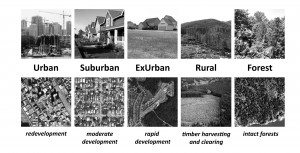
King County and the City of Seattle have both issued bold carbon emission goals — up to 80% reduction of greenhouse gas emission below today’s levels by 2050 (KCCP 2007). Meanwhile, the population in Seattle is projected to grow at a rate of 32.4% between 2005 and 2030 (Washington Office of Financial Management, 2007). As the Seattle regional population grows, we can expect significant land cover and land use changes that will directly affect urban carbon emissions, as well as carbon stocks in vegetation and overall rates of carbon exchange. The rapid increase in public policy attention towards our urban carbon budget requires more comprehensive studies of ecosystems structure and urban growth.
Urbanization affects the structure and function of Earth’s ecosystems through alteration of biophysical processes and habitat (Carpenter et al. 1998, Kareiva et al. 2007), modification of major biogeochemical cycles (Kaye et al. 2006), and active land use management decisions. Environmental changes resulting from urbanization, in turn, feed back and affect human and ecological well-being (Patz et al. 2005). There are very few data available to systematically evaluate how alternative patterns of urban development interact with ecosystem processes.
Native vegetation, agricultural, urban, and residential landscapes have different total terrestrial carbon stocks, rates of carbon exchange, and potentials for carbon sequestration. Changes in land use, land cover, and/or their spatial distribution affect the stocks and fluxes of carbon in terrestrial ecosystems. Further, ecosystem disturbances, whether natural or anthropogenic, can change an area from a carbon sink to a carbon source or vice versa.
Urban development choices pay a central role in determining local, regional, and global carbon emissions through such factors as energy consumption and transportation, as well as terrestrial carbon sinks via vegetation carbon storage and uptake. While it is clear that urban areas are very important in the carbon cycle, the exact magnitude of and mechanisms for carbon exchange are largely uncertain for urbanizing regions (Pataki et al. 2006). There are very few data available to systematically evaluate how alternative patterns of urban development, i.e., centralized versus sprawling, interact with ecosystem processes.
Empirical data linking urban patterns and ecosystem carbon storage and exchange are critical to inform urban planning and management, and are essential to meeting our goals of carbon emissions reductions in the face of growing population pressures. While theories of sustainable urban development abound, truly effective implementation must include empirical validation and integrative assessment of the coupled human and natural consequences of our development choices. By approaching this work scientifically through hypothesis testing of the underlying mechanistic changes associated with urban development patterns we will gain insight to the root causes of changes in the urban carbon cycle.
Read more:
Projects: Linking urbanization and vegetation carbon patterns